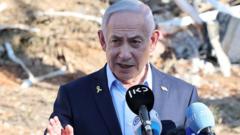Will Ceasefire Talks in Qatar Change the Game as Netanyahu Visits Washington?

Current Ceasefire Talks Between Israel and Hamas: A Complex Path to Peace
The ongoing conflict between Israel and Hamas has escalated tensions in the region, leading to a humanitarian crisis that continues to affect countless lives. As delegations from both parties engage in indirect ceasefire talks in Qatar, the stakes are high. Israeli Prime Minister Benjamin Netanyahu's upcoming meeting with U.S. President Donald Trump adds another layer of complexity to the negotiations. The goal? To reach a ceasefire that addresses the dire need for peace while acknowledging the harsh realities on the ground.
Understanding the Context of the Ceasefire Talks
Ceasefire talks are often fraught with challenges, particularly in a situation as delicate as the Israeli-Palestinian conflict. The latest discussions come in the wake of a series of escalations, including Israel's military operations in Gaza and Hamas's retaliatory actions. The backdrop of these talks is a landscape marked by loss, with significant casualties reported on both sides.
The Historical Background
The conflict between Israel and Hamas dates back decades, rooted in deep-seated political, territorial, and religious disputes. The situation worsened after the October 7, 2023, attacks by Hamas, where approximately 1,200 people were killed and 251 individuals were taken hostage. In response, Israel launched a military campaign aimed at dismantling Hamas's operational capabilities. The ensuing violence has led to staggering civilian casualties, with reports indicating over 57,000 people killed in Gaza since the conflict reignited.
Current Conditions and Positions
As negotiations commence in Qatar, both Israel and Hamas have outlined their positions, revealing significant gaps that could impede progress. Israel seeks to achieve three primary objectives:
- Secure the release and return of all hostages.
- Weaken and dismantle Hamas's military capabilities.
- Establish conditions to ensure Gaza no longer poses a threat to Israel.
On the other hand, Hamas has reiterated its demands, including:
- A full cessation of hostilities at the conclusion of any truce.
- The withdrawal of Israeli troops from Gaza.
Both parties have previously rejected compromising on these key issues, making the current round of talks all the more critical.
The Role of Mediators
Qatari and Egyptian mediators are tasked with navigating the complexities of these negotiations, aiming to bridge the gaps between the two sides. Historically, mediation efforts have struggled to produce lasting agreements, often collapsing under the weight of entrenched positions and mutual distrust.
The Impact of International Involvement
Netanyahu's meeting with Trump is anticipated to influence the dynamics of the ceasefire talks. The U.S. has traditionally played a significant role in Middle Eastern diplomacy, and Trump's position may sway Netanyahu's approach to negotiations. Observers speculate that Trump's insistence on a rapid resolution could prompt Israel to reconsider its hardline stance, especially in light of public outcry for the release of hostages.
The Human Cost of the Conflict
The humanitarian crisis in Gaza continues to escalate, with civilians bearing the brunt of the violence. Hospitals are overwhelmed, and essential services are strained as aid remains limited. According to reports, over 30 individuals were killed in a single day as Israel intensified its military operations, emphasizing the urgent need for a ceasefire.
The Voices of the People
Within Israel, public sentiment is shifting. Many citizens have taken to the streets, demanding that their government prioritize the release of hostages and work towards a peaceful resolution. This grassroots movement underscores the growing impatience among the Israeli populace, who are increasingly aware of the human cost of sustained conflict.
Challenges Ahead
Despite the apparent momentum towards a potential ceasefire, significant challenges remain. Hardline elements within Netanyahu's cabinet, including figures like Itamar Ben Gvir and Bezalel Smotrich, express strong opposition to any agreement that does not ensure the complete dismantling of Hamas. This internal political pressure complicates the already intricate negotiations, raising the question of whether a viable compromise can be reached.
The Perspectives of the Hostages’ Families
Families of the hostages continue to grapple with uncertainty and grief, hoping for a resolution that might bring their loved ones home. Their plight adds a poignant dimension to the negotiations, as both sides are reminded of the human lives at stake. This emotional aspect may serve as a catalyst for reaching a ceasefire, especially as public pressure mounts on Netanyahu's government.
Potential Outcomes of the Talks
As the indirect talks unfold, several potential outcomes could emerge:
- A comprehensive ceasefire agreement that addresses key demands from both sides.
- A phased approach to ceasefire, where initial steps are taken while further negotiations continue.
- The possibility of continued hostilities if no agreement is reached, leading to further escalation.
Each outcome carries significant implications for the region, the civilians impacted by the conflict, and the broader international community.
Conclusion: The Path Forward
The current ceasefire talks between Israel and Hamas represent a critical juncture in the ongoing conflict. As both sides grapple with their demands and the harsh realities on the ground, the role of mediators and international actors becomes increasingly important. The lives of countless civilians hang in the balance, underscoring the urgent need for a resolution that prioritizes peace and the protection of human rights.
As the world watches closely, the question remains: Can this round of negotiations lead to a lasting peace, or will it once again fall short of expectations? The stakes are high, and the path forward is fraught with uncertainty. How will the leaders involved navigate these turbulent waters to find common ground?
FAQs
What are the main objectives of the ceasefire talks between Israel and Hamas?
The main objectives include securing the release of hostages, dismantling Hamas's military capabilities, and establishing conditions that prevent Gaza from posing a future threat to Israel.
Who is mediating the ceasefire talks?
Qatari and Egyptian officials are mediating the current round of indirect talks between Israel and Hamas.
What challenges do the negotiators face?
Negotiators face challenges such as entrenched positions from both sides, internal political pressures within the Israeli government, and the urgent humanitarian crisis in Gaza.
What is the humanitarian situation in Gaza?
The humanitarian situation in Gaza is dire, with significant civilian casualties and a lack of access to essential services due to the ongoing conflict.
How are the families of hostages responding to the situation?
Families of hostages are publicly advocating for a ceasefire and the release of their loved ones, expressing their grief and urgency during protests and public gatherings.
This complex situation requires careful navigation and compassion from all parties involved. As we reflect on these critical negotiations, what are your thoughts on the potential for peace in such a fraught environment? #IsraelHamasCeasefire #MiddleEastPeace #HumanRights
Published: 2025-07-06 20:32:08 | Category: world



